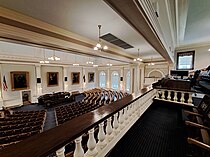
Back مجلس نواب نيوهامبشير Arabic Repräsentantenhaus von New Hampshire German Cámara de Representantes de Nuevo Hampshire Spanish Chambre des représentants du New Hampshire French בית הנבחרים של ניו המפשייר HE Camera dei rappresentanti del New Hampshire Italian ニューハンプシャー州議会代議院 Japanese Câmara dos Representantes de Nova Hampshire Portuguese New Hampshire House of Representatives SIMPLE New Hampshires representanthus Swedish
New Hampshire House of Representatives | |
|---|---|
| New Hampshire General Court | |
 | |
| Type | |
| Type | |
Term limits | None |
| History | |
New session started | December 4, 2024 |
| Leadership | |
Speaker pro tempore | |
Majority Leader | |
Minority Leader | |
| Structure | |
| Seats | 400 |
 | |
Political groups | Majority
Minority
|
Length of term | 2 years |
| Authority | Part Second, New Hampshire Constitution |
| Salary | $200/term ($100/year), plus daily travel |
| Elections | |
| Plurality block voting | |
Last election | November 5, 2024 |
Next election | November 3, 2026 |
| Redistricting | Legislative control |
| Meeting place | |
 | |
| House of Representatives Chamber New Hampshire State House Concord, New Hampshire | |
| Website | |
| www | |
The New Hampshire House of Representatives is the lower house in the New Hampshire General Court, the bicameral legislature of the state of New Hampshire. The House of Representatives consists of 400 members coming from 203 legislative districts across the state, created from divisions of the state's counties. On average, each legislator represents about 3,300 residents, which is the smallest state legislative population-to-representative ratio in the country.
New Hampshire has by far the largest lower house of any American state; the second-largest, the Pennsylvania House of Representatives, has 203 members. The House is the fourth-largest lower house in the English-speaking world (behind the 435-member United States House of Representatives, 543-member Lok Sabha of India, and 650-member House of Commons of the United Kingdom).[2]
Districts vary in number of seats based on their populations, with the least-populous districts electing only one member and the most populous electing 10, not counting floterial seats.[3]
Voters are allowed to cast as many votes as there are seats to be filled in the district. For instance, in a two-member district, a voter can vote for up to two candidates, in a ten-seat district, for up to ten candidates. Plurality block voting often results in one party winning all of the seats in the district, as the (cross-sectional) results below for the current representation attest. Like in the districts elected by First-past-the-post voting, proportionality of party represention is not generally produced.
Some municipalities are in multiple districts, including floterial districts, so as to achieve more equal apportionment by population.
Unlike in many state legislatures, there is no single "aisle" to cross per se, as members of both parties sit partially segregated in five sections. The seat section and number is put on the legislator's motor vehicle license plate, which they pay for if they wish to put one on their personal automobiles, or in the case of the chairpersons and party leaders, their title is put on the legislative plate. Seating location is enforced, as seating is pre-assigned. Although the personal preference of the legislator is asked, usually chairmen and those with special needs are given the preferred aisle seats. The sixth section is the Speaker's seat at the head of the hall.
The House of Representatives has met in Representatives Hall of the New Hampshire State House since 1819. Representatives Hall is thus the oldest chamber in the United States still in continuous legislative use.[4] Large arched windows line the walls. On the rostrum hang portraits of John P. Hale, Abraham Lincoln, George Washington, Franklin Pierce, and Daniel Webster.
- ^ "The General Court of New Hampshire | 404" (PDF). www.gencourt.state.nh.us. Retrieved January 1, 2025.
- ^ Ross, Elizabeth (March 21, 1994). "Bigger Is Sometimes Better For Largest US Legislature". Christian Science Monitor.
- ^ "NH House of Representatives - Elected Officials | Citizens Count". www.citizenscount.org. Retrieved May 9, 2024.
- ^ "New Hampshire House of Representatives "NH House Facts"". Archived from the original on June 18, 2007.